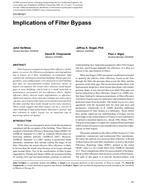Description
Filter bypass can negatively impact filter efficiency. In this paper, we assess the filtration performance and degradation due to bypass of 13 filter installations in residential, light commercial, and large institutional buildings. Bypass gap size, geometry, and configurations were measured in each building and then an experimentally-verified analytical model of bypass was applied. The results show relatively small bypass gaps in most buildings, which lead to a small reduction in performance, particularly for low-efficiency filters. Higher efficiency filters showed larger degradations in efficiency. Additional analysis shows that duct leakage into return ducts can also cause bypass if the leaks are located downstream from the filter and that these leaks should receive more attention. These results suggest that filter bypass can be a concern in some buildings if high-performance filtration is desired, and that solutions to reduce bypass are an important step in improving indoor air quality.
Units: Dual
Citation: ASHRAE Transactions, vol. 115, pt. 1, Chicago 2009
Product Details
- Published:
- 2009
- Number of Pages:
- 8
- File Size:
- 1 file , 230 KB
- Product Code(s):
- D-CH-09-021




